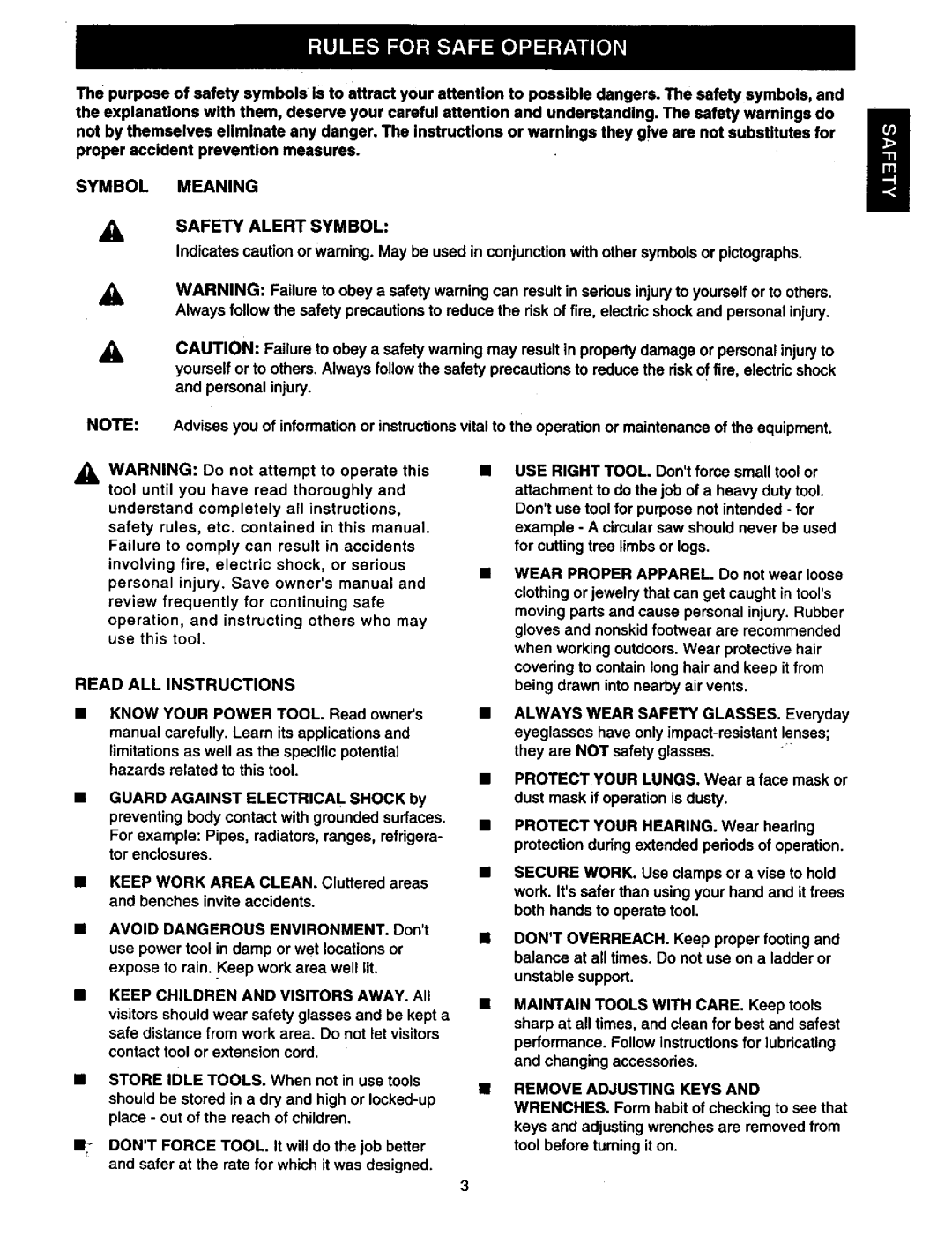
The purpose of safety symbols Is to attract your attention to possible dangers. The safety symbols, and the explanations with them, deserve your careful attention and understanding. The safety warnings do not by themselves eliminate any danger. The instructions or warnings they g!ve are not substitutes for proper accident prevention measures.
SYMBOL MEANING
A
SAFETY ALERT SYMBOL:
Indicates caution or waming. May be used in conjunction with other symbols or pictographs.
WARNING: Failure to obey s safety waming can result in serious injury to yourself or to others. Always follow the safety precautions to reduce the risk of fire, electric shock and personal injury.
A | CAUTION: | Failure to obey a safety waming may result in property damage or personal injuryto | |||||
| yourself or to others. Always follow the safety precautions to reduce the dsk of fire, electric shock | ||||||
| and personal injury. |
|
|
| |||
NOTE: | Advises you of information or instructionsvital to the operation or maintenance of the equipment. | ||||||
WARNING: | Do not attempt | to operate this | M USE RIGHT TOOL. Don'tforce small tool or | ||||
tool until you | have | read thoroughly and |
| attachment to do the job of a heavy duty tool. | |||
understand completely | all instructions, |
| Don'tuse tool for purpose not intended - for | ||||
safety | rules, | etc. contained | in this manual. |
| example - A circular saw should never be used | ||
Failure to comply can result in accidents |
| for cutting tree limbs or logs. | |||||
involving fire, electric | shock, or serious | • | WEAR PROPER APPAREL. Do not wear loose | ||||
personal injury. Save owner's manual and |
| ||||||
| clothing or jewelry that can get caught in tool's | ||||||
review frequently for continuing safe |
| ||||||
| moving parts and cause personal injury. Rubber | ||||||
operation, and instructing others who may |
| ||||||
| gloves and nonskid footwear are recommended | ||||||
use this tool. |
|
|
|
|
| ||
|
|
|
|
| when working outdoors. Wear protective hair | ||
|
|
|
|
|
|
| |
READ ALL | INSTRUCTIONS |
|
|
| covering to contain long hair and keep it from | ||
|
|
| being drawn into nearby air vents. | ||||
•KNOW YOUR POWER TOOL. Read owner's • ALWAYS WEAR SAFETY GLASSES. Everyday
manual carefully. Learn its applications and | eyeglasses have only | ||
limitations as well as the specific potential | they are NOT safety glasses. | " | |
hazards | related to this tool. | PROTECT YOUR LUNGS. Wear a face mask or | |
|
| ||
GUARD | AGAINST ELECTRICAL SHOCK by | dust mask if operation is dusty. |
|
preventing body contact with grounded surfaces. For example: Pipes, radiators, ranges, refrigera-
PROTECT YOUR HEARING. Wear hearing
tor enclosures.
protection during extended periods of operation.
SECURE WORK. Use clamps or a vise to hold
•KEEP WORK AREA CLEAN. Cluttered areas
and benches invite accidents.
work. It'ssafer than using your hand and it frees both hands to operate tool.
•AVOID DANGEROUS ENVIRONMENT. Don't
| use power tool in damp or wet locations or | m DON'TOVERREACH. | Keep proper footing and | |
|
| balance at all times. Do not use on a ladder or | ||
| expose to rain. Keep work area well lit. |
| ||
|
| unstable support. |
| |
|
|
|
| |
• | KEEP CHILDREN AND VISITORS AWAY. All | • | MAINTAIN TOOLS WITH CARE. Keep tools | |
| visitors should wear safety glasses and be kept a |
| ||
|
| sharp at all times, and clean for best and safest | ||
| safe distance from work area. Do not let visitors |
| ||
|
| performance. Follow instructions for lubricating | ||
| contact tool or extension cord. |
| ||
|
| and changing accessories. | ||
|
|
| ||
• | STORE IDLE TOOLS. When not in use tools |
| REMOVE ADJUSTING | KEYS AND |
| should be stored in a dry and high or |
| ||
|
| WRENCHES. Form habit of checking to see that | ||
| place - out of the reach of children. |
| ||
|
| keys and adjusting wrenches are removed from | ||
|
|
| ||
| DON'T FORCE TOOL. It will do the job better |
| tool before tuming it on. | |
| and safer at the rate for which it was designed. |
|
|
|
3
